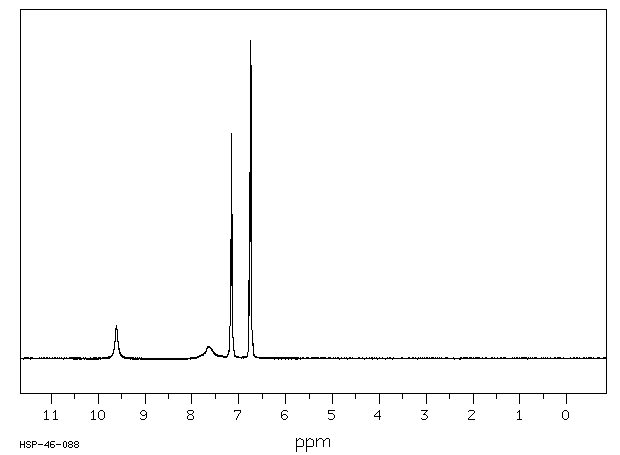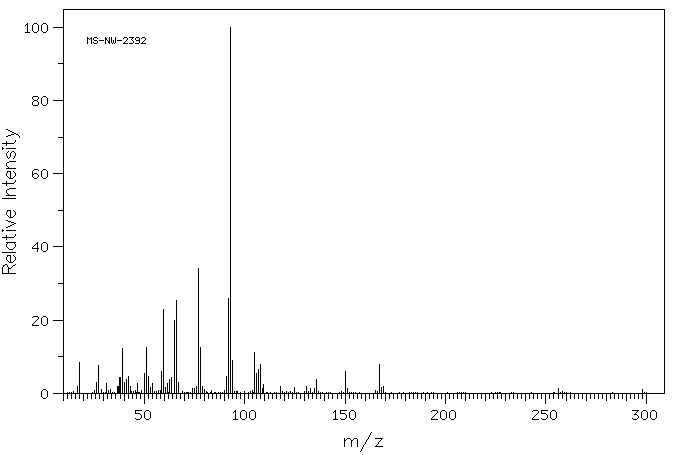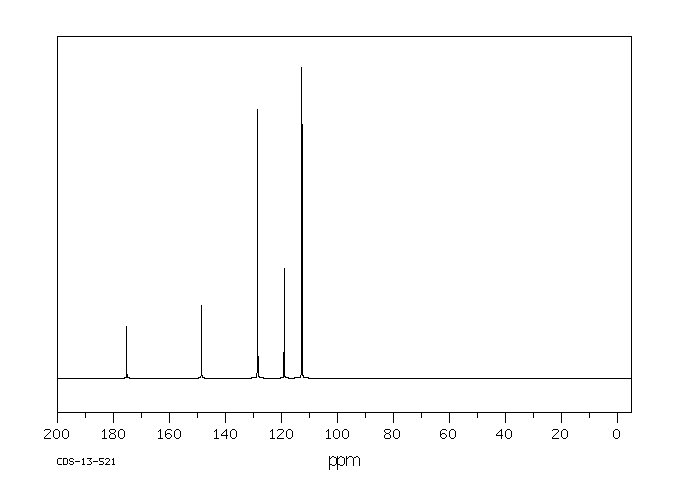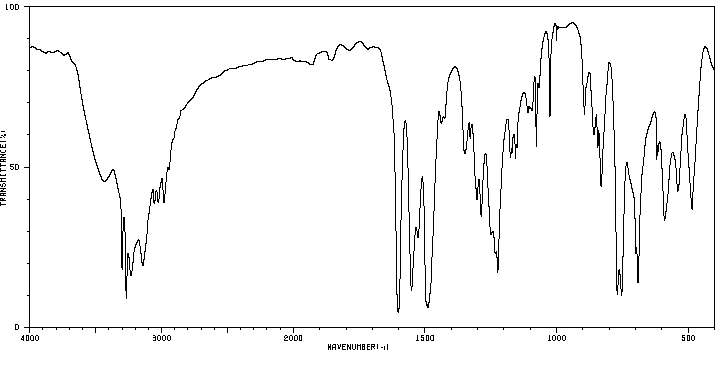二苯基硫代卡巴肼 | 622-03-7
中文名称
二苯基硫代卡巴肼
中文别名
二苯基硫代羰二肼;二苯基硫卡巴肼;二苯氨基硫脲;二苯胺基代硫脲;二苯氨基代硫脲;二苯硫代碳酰二肼;二苯基硫代碳二肼
英文名称
diphenyl thiocarbazide
英文别名
1,5-diphenylthiocarbonohydrazide;Diphenylthiocarbazid;Diphenylthiocarbazide;1,3-dianilinothiourea
CAS
622-03-7
化学式
C13H14N4S
mdl
MFCD00046042
分子量
258.347
InChiKey
BNSNUHPJRKTRNT-UHFFFAOYSA-N
BEILSTEIN
——
EINECS
——
-
物化性质
-
计算性质
-
ADMET
-
安全信息
-
SDS
-
制备方法与用途
-
上下游信息
-
文献信息
-
表征谱图
-
同类化合物
-
相关功能分类
-
相关结构分类
物化性质
-
熔点:155°C
-
沸点:181°C (rough estimate)
-
密度:1.2302 (rough estimate)
-
溶解度:略溶。在乙醇中
计算性质
-
辛醇/水分配系数(LogP):3.7
-
重原子数:18
-
可旋转键数:4
-
环数:2.0
-
sp3杂化的碳原子比例:0.0
-
拓扑面积:80.2
-
氢给体数:4
-
氢受体数:3
安全信息
-
安全说明:S22,S36/37/39
-
危险类别码:R22,R36/37/38
-
RTECS号:FF2800000
-
海关编码:2930909090
-
储存条件:存储条件为0-10°C,应存放在惰性气体中,并避免光照、空气以及加热。
SDS
Section I.Chemical Product and Company Identification
Chemical Name Diphenylthiocarbazide
Portland OR
Synonym Carbonothioic Dihydrazide, 2,2'-diphenyl- (9 CI)
Chemical Formula C6H5NHNHCSNHNHC6H5
CAS Number 622-03-7
Section II. Composition and Information on Ingredients
Chemical Name CAS Number Percent (%) TLV/PEL Toxicology Data
Diphenylthiocarbazide 622-03-7 ---------- Not available. Rat LD50 (oral) 1500mg/kg
Mouse LD50 (intraperitoneal)
200mg/kg
Section III. Hazards Identification
Acute Health Effects Harmful if ingested or inhaled. Minimize exposure to this material. Severe overexposure can result in injury or death.
Irritating to eyes and skin on contact. Inhalation causes irritation of the lungs and respiratory system. Inflammation of the
eye is characterized by redness, watering, and itching. Skin inflammation is characterized by itching, scaling, reddening,
or, occasionally, blistering.
Follow safe industrial hygiene practices and always wear proper protective equipment when handling this compound.
CARCINOGENIC EFFECTS : Not available.
Chronic Health Effects
MUTAGENIC EFFECTS : Not available.
TERATOGENIC EFFECTS : Not available.
DEVELOPMENTAL TOXICITY: Not available.
Repeated or prolonged exposure to this compound is not known to aggravate existing medical conditions.
Section IV. First Aid Measures
Eye Contact Check for and remove any contact lenses. In case of contact, immediately flush eyes with plenty of water for at least 15
minutes. Get medical attention.
Skin Contact In case of contact, immediately flush skin with plenty of water. Remove contaminated clothing and shoes. Wash clothing
before reuse. Thoroughly clean shoes before reuse. Get medical attention.
Inhalation If the victim is not breathing, perform mouth-to-mouth resuscitation. Loosen tight clothing such as a collar, tie, belt or
waistband. If breathing is difficult, oxygen can be administered. Seek medical attention if respiration problems do not
improve.
Ingestion INDUCE VOMITING by sticking finger in throat. Lower the head so that the vomit will not reenter the mouth and throat.
Loosen tight clothing such as a collar, tie, belt or waistband. If the victim is not breathing, perform mouth-to-mouth
resuscitation. Examine the lips and mouth to ascertain whether the tissues are damaged, a possible indication that the
toxic material was ingested; the absence of such signs, however, is not conclusive.
Section V. Fire and Explosion Data
Auto-Ignition Not available.
Flammability May be combustible at high temperature.
Flash Points Flammable Limits Not available.
Not available.
Combustion Products These products are toxic carbon oxides (CO, CO 2), nitrogen oxides (NO, NO2), sulfur oxides (SO2, SO3...).
Fire Hazards
Not available.
Risks of explosion of the product in presence of mechanical impact: Not available.
Explosion Hazards
Risks of explosion of the product in presence of static discharge: Not available.
Fire Fighting Media
SMALL FIRE: Use DRY chemical powder.
and Instructions LARGE FIRE: Use water spray, fog or foam. DO NOT use water jet.
Consult with local fire authorities before attempting large scale fire-fighting operations.
Continued on Next Page
Diphenylthiocarbazide
Section VI. Accidental Release Measures
Spill Cleanup Harmful material. Irritating material.
Instructions Use a shovel to put the material into a convenient waste disposal container. Finish cleaning the spill by rinsing any
contaminated surfaces with copious amounts of water. Consult federal, state, and/or local authorities for assistance on
disposal.
Section VII. Handling and Storage
Handling and Storage HARMFUL. IRRITANT. Keep away from heat. Mechanical exhaust required. When not in use, tightly seal the container
and store in a dry, cool place. Avoid excessive heat and light. Do not breathe dust.
Information
Always store away from incompatible compounds such as oxidizing agents.
Section VIII. Exposure Controls/Personal Protection
Engineering Controls Use process enclosures, local exhaust ventilation, or other engineering controls to keep airborne levels below
recommended exposure limits. If user operations generate dust, fume or mist, use ventilation to keep exposure to
airborne contaminants below the exposure limit.
Personal Protection Splash goggles. Lab coat. Dust respirator. Boots. Gloves. Suggested protective clothing might not be sufficient; consult
a specialist BEFORE handling this product. Be sure to use a MSHA/NIOSH approved respirator or equivalent.
Exposure Limits Not available.
Section IX. Physical and Chemical Properties
Solubility
Physical state @ 20°C Solid. (White crystalline powder.) Not available.
Not available.
Specific Gravity
Molecular Weight 258.34 Partition Coefficient Not available.
Boiling Point Not available. Vapor Pressure Not applicable.
Melting Point 155°C (311°F) Vapor Density Not available.
Not available. Volatility Not available.
Refractive Index
Critical Temperature Odor Not available.
Not available.
Not available. Not available.
Viscosity Taste
Section X. Stability and Reactivity Data
This material is stable if stored under proper conditions. (See Section VII for instructions)
Stability
Conditions of Instability
Avoid excessive heat and light.
Incompatibilities
Reactive with oxidizing agents.
Section XI. Toxicological Information
RTECS Number FF2800000
Routes of Exposure Eye Contact. Ingestion. Inhalation.
Rat LD50 (oral) 1500mg/kg
Toxicity Data
Mouse LD50 (intraperitoneal) 200mg/kg
Chronic Toxic Effects CARCINOGENIC EFFECTS : Not available.
MUTAGENIC EFFECTS : Not available.
TERATOGENIC EFFECTS : Not available.
DEVELOPMENTAL TOXICITY: Not available.
Repeated or prolonged exposure to this compound is not known to aggravate existing medical conditions.
Acute Toxic Effects Harmful if ingested or inhaled. Minimize exposure to this material. Severe overexposure can result in injury or death.
Irritating to eyes and skin on contact. Inhalation causes irritation of the lungs and respiratory system. Inflammation of the
eye is characterized by redness, watering, and itching. Skin inflammation is characterized by itching, scaling, reddening,
or, occasionally, blistering.
Follow safe industrial hygiene practices and always wear proper protective equipment when handling this compound.
Continued on Next Page
Diphenylthiocarbazide
Section XII. Ecological Information
Ecotoxicity Not available.
Environmental Fate Not available.
Section XIII. Disposal Considerations
Recycle to process, if possible. Consult your local regional authorities. You may be able to dissolve or mix material with a
Waste Disposal
combustible solvent and burn in a chemical incinerator equipped with an afterburner and scrubber system. Observe all
federal, state and local regulations when disposing of the substance.
Section XIV. Transport Information
DOT Classification Not a DOT controlled material (United States).
PIN Number Not applicable.
Proper Shipping Name
Not applicable.
Packing Group (PG) Not applicable.
DOT Pictograms
Section XV. Other Regulatory Information and Pictograms
TSCA Chemical Inventory This compound is ON the EPA Toxic Substances Control Act (TSCA) inventory list.
(EPA)
WHMIS Classification
On NDSL.
(Canada)
EINECS Number (EEC) 210-717-2
EEC Risk Statements R20/21/22- Harmful by inhalation, in contact with skin and if swallowed.
R36/37/38- Irritating to eyes, respiratory system and skin.
Japanese Regulatory Data
SECTION 16 - ADDITIONAL INFORMATION
N/A
制备方法与用途
上下游信息
-
上游原料
中文名称 英文名称 CAS号 化学式 分子量 —— phenyldithiocarbazic acid 14353-52-7 C7H8N2S2 184.286 双硫腙 1,5-diphenyl-thiocarbazone 60-10-6 C13H12N4S 256.331 -
下游产品
中文名称 英文名称 CAS号 化学式 分子量 苯胺基硫脲 1-phenyl-3-thiosemicarbazide 645-48-7 C7H9N3S 167.235 双硫腙 1,5-diphenyl-thiocarbazone 60-10-6 C13H12N4S 256.331 —— Dithizone 60-10-6 C13H12N4S 256.331
反应信息
-
作为反应物:描述:参考文献:名称:Fischer,E.; Besthorn, Justus Liebigs Annalen der Chemie, 1882, vol. 212, p. 321摘要:DOI:
-
作为产物:描述:参考文献:名称:Fusco; Romani, Gazzetta Chimica Italiana, 1946, vol. 76, p. 419,435摘要:DOI:
文献信息
-
A Novel Method for the Synthesis of Disubstituted Ureas and Thioureas Under Microwave Irradiaton作者:Mohammad M. Mojtahedi、Mohammad R. Saidi、Mohammad BolourtchianDOI:10.1039/a906441i日期:——Several symmetrically disubstituted ureas and thioureas are synthesized by heating of urea or thiourea with aromatic amines or phenylhydrazine under environmentally benign conditions without any solvent in a conventional microwave oven.
-
Green Process Development for the Synthesis of Aliphatic Symmetrical <i>N,N′</i>-Disubstituted Thiourea Derivatives in Aqueous Medium作者:Asha D. Jangale、Priyanka P. Kumavat、Yogesh B. Wagh、Yogesh A. Tayade、Pramod P. Mahulikar、Dipak S. DalalDOI:10.1080/00397911.2014.960939日期:2015.1.17Abstract A highly efficient green process for the synthesis of N,N′-disubstituted aliphatic thiourea derivatives using primary aliphatic amines and carbon disulfide in aqueous medium at room temperature via a nonisothiocyanate route is described. This protocol illustrates the rapid preparation of N,N′-disubstituted aliphatic thiourea derivatives in excellent yields with some advantages such as no catalyst
-
Synthesis and characterization of a series of cobalt complexes: Investigation of their efficacy as sensitizers in dye-sensitized solar cell applications作者:Vindhya Hegde、C.O. Sreekala、Naveen V. Kulkarni、Dineshchakravarthy Senthurpandi、Jomon MathewDOI:10.1016/j.molstruc.2022.133512日期:2022.10using Tauc plot. Utility of the prepared cobalt (II/III) complexes as sensitizers in the dye-sensitized solar cell was investigated. I–V parameters of the fabricated solar cells were noted and compared with the cell made using standard N719 dye. Among the twenty-one complexes investigated, complex C4, comprising of bis(pyrazolyl)methane ligands exhibited highest power conversion efficiency.
-
ANTICORROSIVE COATING COMPOSITIONS申请人:Dai Nippon Toryo Co., Ltd.公开号:EP1818379A1公开(公告)日:2007-08-15It is an object of the present invention to provide an anticorrosive coating composition which uses a pollution-free (heavy metal-free) rust preventive pigment and exhibits anticorrosive performances equal or superior to those of lead compounds or chromic acid compounds even if the pigment is blended in various binder resins and also to provide an anticorrosive coating composition having excellent storage stability. The present invention relates to an anticorrosive coating composition comprising a binder resin and a pollution-free (heavy metal-free) rust preventive pigment containing a condensed calcium phosphate produced by baking a single substance or mixture of a calcium component and a phosphorous component in the following atomic ratio (Ca/P = m): 0.50 < m < 1.00, at 180 to 350°C.
-
Fischer,E., Justus Liebigs Annalen der Chemie, 1878, vol. 190, p. 136作者:Fischer,E.DOI:——日期:——
表征谱图
-
氢谱1HNMR
-
质谱MS
-
碳谱13CNMR
-
红外IR
-
拉曼Raman
-
峰位数据
-
峰位匹配
-
表征信息
同类化合物
(βS)-β-氨基-4-(4-羟基苯氧基)-3,5-二碘苯甲丙醇
(S,S)-邻甲苯基-DIPAMP
(S)-(-)-7'-〔4(S)-(苄基)恶唑-2-基]-7-二(3,5-二-叔丁基苯基)膦基-2,2',3,3'-四氢-1,1-螺二氢茚
(S)-盐酸沙丁胺醇
(S)-3-(叔丁基)-4-(2,6-二甲氧基苯基)-2,3-二氢苯并[d][1,3]氧磷杂环戊二烯
(S)-2,2'-双[双(3,5-三氟甲基苯基)膦基]-4,4',6,6'-四甲氧基联苯
(S)-1-[3,5-双(三氟甲基)苯基]-3-[1-(二甲基氨基)-3-甲基丁烷-2-基]硫脲
(R)富马酸托特罗定
(R)-(-)-盐酸尼古地平
(R)-(-)-4,12-双(二苯基膦基)[2.2]对环芳烷(1,5环辛二烯)铑(I)四氟硼酸盐
(R)-(+)-7-双(3,5-二叔丁基苯基)膦基7''-[((6-甲基吡啶-2-基甲基)氨基]-2,2'',3,3''-四氢-1,1''-螺双茚满
(R)-(+)-7-双(3,5-二叔丁基苯基)膦基7''-[(4-叔丁基吡啶-2-基甲基)氨基]-2,2'',3,3''-四氢-1,1''-螺双茚满
(R)-(+)-7-双(3,5-二叔丁基苯基)膦基7''-[(3-甲基吡啶-2-基甲基)氨基]-2,2'',3,3''-四氢-1,1''-螺双茚满
(R)-(+)-4,7-双(3,5-二-叔丁基苯基)膦基-7“-[(吡啶-2-基甲基)氨基]-2,2”,3,3'-四氢1,1'-螺二茚满
(R)-3-(叔丁基)-4-(2,6-二苯氧基苯基)-2,3-二氢苯并[d][1,3]氧杂磷杂环戊烯
(R)-2-[((二苯基膦基)甲基]吡咯烷
(R)-1-[3,5-双(三氟甲基)苯基]-3-[1-(二甲基氨基)-3-甲基丁烷-2-基]硫脲
(N-(4-甲氧基苯基)-N-甲基-3-(1-哌啶基)丙-2-烯酰胺)
(5-溴-2-羟基苯基)-4-氯苯甲酮
(5-溴-2-氯苯基)(4-羟基苯基)甲酮
(5-氧代-3-苯基-2,5-二氢-1,2,3,4-oxatriazol-3-鎓)
(4S,5R)-4-甲基-5-苯基-1,2,3-氧代噻唑烷-2,2-二氧化物-3-羧酸叔丁酯
(4S,4''S)-2,2''-亚环戊基双[4,5-二氢-4-(苯甲基)恶唑]
(4-溴苯基)-[2-氟-4-[6-[甲基(丙-2-烯基)氨基]己氧基]苯基]甲酮
(4-丁氧基苯甲基)三苯基溴化磷
(3aR,8aR)-(-)-4,4,8,8-四(3,5-二甲基苯基)四氢-2,2-二甲基-6-苯基-1,3-二氧戊环[4,5-e]二恶唑磷
(3aR,6aS)-5-氧代六氢环戊基[c]吡咯-2(1H)-羧酸酯
(2Z)-3-[[(4-氯苯基)氨基]-2-氰基丙烯酸乙酯
(2S,3S,5S)-5-(叔丁氧基甲酰氨基)-2-(N-5-噻唑基-甲氧羰基)氨基-1,6-二苯基-3-羟基己烷
(2S,2''S,3S,3''S)-3,3''-二叔丁基-4,4''-双(2,6-二甲氧基苯基)-2,2'',3,3''-四氢-2,2''-联苯并[d][1,3]氧杂磷杂戊环
(2S)-(-)-2-{[[[[3,5-双(氟代甲基)苯基]氨基]硫代甲基]氨基}-N-(二苯基甲基)-N,3,3-三甲基丁酰胺
(2S)-2-[[[[[((1S,2S)-2-氨基环己基]氨基]硫代甲基]氨基]-N-(二苯甲基)-N,3,3-三甲基丁酰胺
(2S)-2-[[[[[[((1R,2R)-2-氨基环己基]氨基]硫代甲基]氨基]-N-(二苯甲基)-N,3,3-三甲基丁酰胺
(2-硝基苯基)磷酸三酰胺
(2,6-二氯苯基)乙酰氯
(2,3-二甲氧基-5-甲基苯基)硼酸
(1S,2S,3S,5S)-5-叠氮基-3-(苯基甲氧基)-2-[(苯基甲氧基)甲基]环戊醇
(1S,2S,3R,5R)-2-(苄氧基)甲基-6-氧杂双环[3.1.0]己-3-醇
(1-(4-氟苯基)环丙基)甲胺盐酸盐
(1-(3-溴苯基)环丁基)甲胺盐酸盐
(1-(2-氯苯基)环丁基)甲胺盐酸盐
(1-(2-氟苯基)环丙基)甲胺盐酸盐
(1-(2,6-二氟苯基)环丙基)甲胺盐酸盐
(-)-去甲基西布曲明
龙蒿油
龙胆酸钠
龙胆酸叔丁酯
龙胆酸
龙胆紫-d6
龙胆紫










